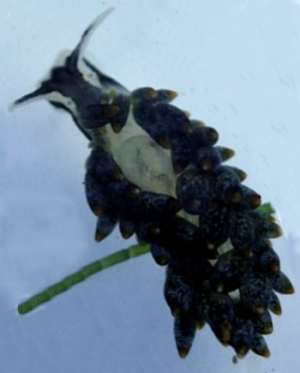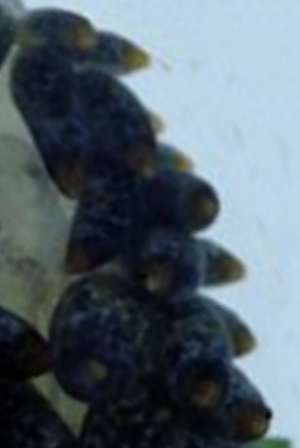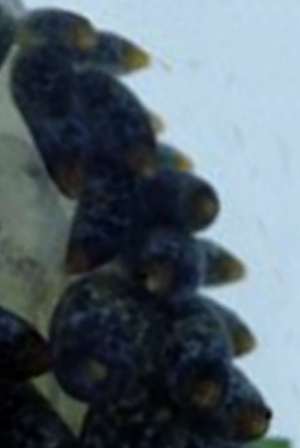

Ercolania emarginata
Jensen, 1985
Order: SACOGLOSSA
Superfamily: LIMAPONTIOIDEA
Family: Limapontiidae
DISTRIBUTION
Known from Hong Kong
PHOTO
Cape d'Aguilar, Hong Kong, South China Sea. Depth: less than 1 m during low tide. 12 April 1995. Very exposed rocky shore. Photographer: Kathe Jensen. The lack of black pigmentation on the dorsum of this specimen and the mottled black on the cerata suggests this is an intermediate colour form between intertidal and subtidal specimens.
Note: See messages [#2441, #13202] from Kathe Jensen suggesting that this species is a synonym of Ercolania boodleae (Baba, 1938).
This species was described with 2 distinct colour forms. Subtidal animals are almost completely black with bright orange tips to the cerata. The tips and ventral parts of the rhinophores are colourless, and a colourless band extends down each side of the head. There is a black medio-dorsal band running back between the cerata [which is absent in accompanying photos]. Intertidal specimens differ considerably, especially in the absence of black and orange pigmentation on the cerata, which appear green - from digestive gland contents - wit a white tip. The pigmentation on the rest of the body is similar to subtidal specimens but the intensity of the black pigmentation is lower. The photographed animal has an intermediate colour pattern. It grows to approximately 20 mm in length. Subtidal animals found feeding on a coarse dark green filamentous green algae, Cladophora sp.; and intertidal animals fed on a coarse species of Chaetomorpha.
-
Jensen, K.R. (1985) Annotated checklist of Hong Kong Ascoglossa (Mollusca: Opisthobranchia), with descriptions of four new species. In: Proceedings of the 2nd International Workshop on the Malacofauna of Hong Kong and Southern China, Hong Kong, 1983. (Eds: Morton, B; Dudgeon, D) Hong Kong University Press, Hong Kong, 77-107.
Rudman, W.B., 2005 (February 28) Ercolania emarginata Jensen, 1985. [In] Sea Slug Forum. Australian Museum, Sydney. Available from http://www.seaslugforum.net/find/ercoemar
Related messages
Re: Ercolania emarginata from Hong Kong
March 3, 2005
From: Kathe R. Jensen
Dear Bill,
Thanks for pointing out the unpigmented pericardium in this animal [message #13202]. I hadn't really paid attention to that before. One other thing that I should mention is that in 1995 I also collected 2 specimens without the orange/brown tips on the cerata. I had only collected one animal along with all the E. emarginata, and couldn't understand why it didn't copulate with the others - or produce any eggs - until I collected the second specimen! So there is apparently a "sibling" species, but since I only have those 2 specimens, they are still sitting on my shelf.
Greetings,
Kathe:
krjensen@zmuc.ku.dk
Jensen, K.R., 2005 (Mar 3) Re: Ercolania emarginata from Hong Kong. [Message in] Sea Slug Forum. Australian Museum, Sydney. Available from http://www.seaslugforum.net/find/13262Ercolania emarginata from Hong Kong
February 28, 2005
From: Kathe R. Jensen

Dear Bill,
Here is another sacoglossan from Hong Kong. This specimen was collected at Cape d'Aguilar at the Swire Marine Institute during the international workshop in April 1995. The picture was taken in the lab. on 12 April 1995. The species was collected - and feeding on Chaetomorpha antennina.
The species was originally described in 1985 based on specimens collected from the same locality in April 1983. Comparing it with pictures of Ercolania boodleae on the Sea Slug Forum in 2000 has made me almost certain that E. emarginata is identical to E. boodleae [see message #2441 ].
Locality: Cape d'Aguilar, Hong Kong, South China Sea. Depth: less than 1 m during low tide. 12 April 1995. Very exposed rocky shore. Photographer: Kathe Jensen
All the best,
Kathe
krjensen@zmuc.ku.dk


Dear Kathe,
Thanks for this photo. Even if I say so myself, the ability to compare photographs of living animals like this on the Forum, has become an indispensable tool in our taxonomic research. It is unfortunate that some scientific administrators remain blind to its value.
To only difference in colour I can see is that in your photo the dorsum, between the cerata, is white or colourless, whereas in Japanese E. boodleae and Australian E. margaritae [as E. cf. boodleae] the back is black. I note in your description of E. emarginata, you describe 2 colour forms. A subtidal form which is identical in colour to E. boodleae, and an intertidal form in which the ceratal wall lacks black and orange pigmentation, and so the green of the digestive gland shows through the ceratal wall. In the intertidal form the black pigmentation on the back is not so intense. The animal in your photo seems to be intermediate between those two colour forms. What do you think?
Best wishes,
Bill Rudman
